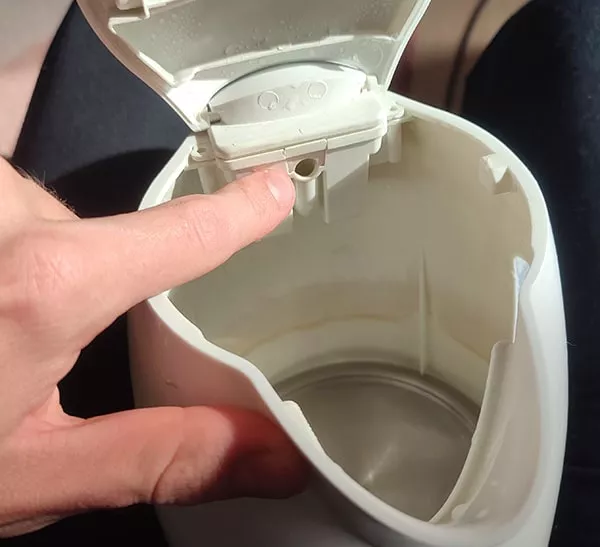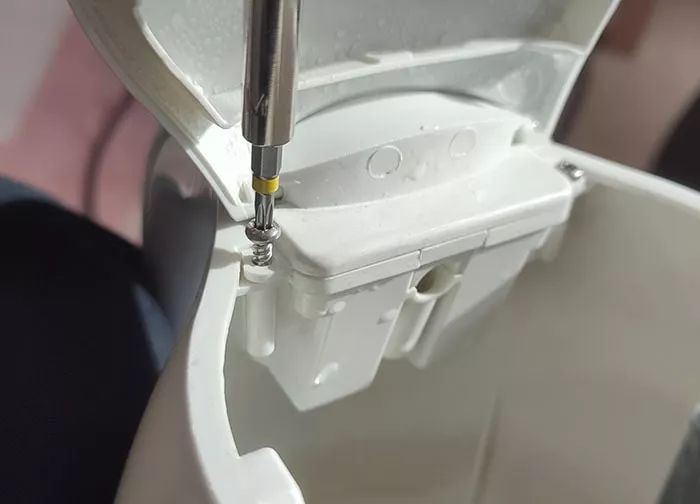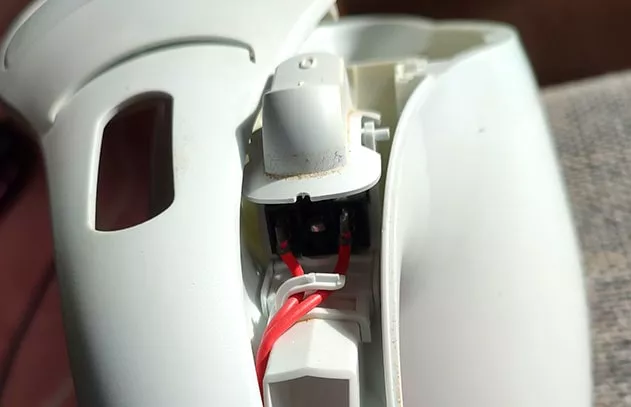Your electric kettle keeps boiling and doesn’t shut off? This is both frustrating and dangerous.
But don’t worry - you’ve landed in the right place. In this comprehensive guide, we’ll have a look at why your kettle keeps boiling (there are just 4 possible reasons) and how to fix each of the causes.
While writing this article, I discovered that kettles are actually incredibly easy to fix. At most, you’re going to need a screwdriver and a replacement switch (which costs just a few dollars).
And that’s the worst case!
In 3 out of 4 cases, you need no tools at all.
So, anyone can fix an electric kettle.
I’m Daniel, an electrical engineer, and I like to take things apart. For this article, I disassembled my kettle and found out how it works.
Let’s have a look.
Safety Info for Kettle Repair
Before attempting to repair your electric kettle, thoroughly dry it with a towel and unplug it.
Do not repair it while it’s standing on its base station.
Generally, electric kettles are safe to repair since they don’t store any power. So, as soon as you lift them off the base, they are without electricity.
How to Fix Your Electric Kettle that Keeps Boiling
Now that you’re prepared, let’s have a look at how to fix your electric kettle and get it to shut off properly.
1. Fix the Lid / Close it Firmly
The very first thing you should make sure when using your electric kettle is to close the lid firmly when boiling water.
Press the lid down until it clicks into place. If the lid on your kettle doesn’t click nicely into place, check the lid’s mounting axis. Is it broken, or are there any obstructions? Fix it.
The lid needs to fit neatly onto the kettle and seal it properly.
Here’s why:
Electric Kettles can’t shut off with an Open Lid
Electric kettles rely on a steam sensor. The steam sensor detects when water boils and cuts off the heating element.
With an open lid, hot steam escapes the kettle and the heating element keeps heating.
Make sure the lid is properly closed and fix any issue that prevents you from properly closing it.
 This is the small hole inside which the steam sensor sits. With an open lid, not enough steam enters the hole and your electric kettle keeps boiling forever.
This is the small hole inside which the steam sensor sits. With an open lid, not enough steam enters the hole and your electric kettle keeps boiling forever.
2. Replace Bimetal Switch
The “steam sensor switch” we just talked about in the previous section sits right below the ON/OFF button.
It is actually very simple:
Hot steam from the boiling water leaves your kettle’s main chamber through a small steam escape hole.
That hole forwards the steam to a small black box sitting below the ON/OFF button inside your electric kettle’s handle.
Inside (or below) that black box, there is a small piece of metal that is actually two different kinds of metal glued together.
When the hot steam heats up this bimetallic metal piece, the two sheets of metal bend at different rates, which causes tension to build up. And exactly when water reaches the boiling point, the bimetal switch is so hot that it bends sharply (which is the clicking sound you can hear), which closes a shutoff circuit and cuts off the heating element.
Some electric kettles have multiple such switches, but usually, the one controlling the boiling-point shutoff is the one inside the handle.
 Unscrew the screws holding your electric kettle’s handle together. Inside the handle sits the sensor that needs replacement.
Unscrew the screws holding your electric kettle’s handle together. Inside the handle sits the sensor that needs replacement.
To fix your kettle that keeps boiling, replace the boiling-point switch. Unscrew the top of the handle to uncover the black switch box. Remove the old switch by unscrewing it and disconnecting the wires.
Insert the new switch, screw it in place, and connect the two power wires.
I recommend getting these replacement bimetal switches for electric kettles (click to view them on amazon).
Alternatively, you can harvest a replacement switch from an old electric kettle that still works! Usually, they are one-size fits all.
 The black sensor box below the switch contains the steam sensor. When the steam sensor switches, it switches the main power (I/O) off.
The black sensor box below the switch contains the steam sensor. When the steam sensor switches, it switches the main power (I/O) off.
3. Check and Adjust Thermostat Settings
Some new kettles come with a precise thermostat that heats the water until the desired target temperature is reached.
Some electric kettles even keep the temperature at target temperature for a defined time span (e.g. 60 minutes).
If your kettle keeps boiling and it has a thermostat control, there are two potential issues:
- the temperature sensor underestimates current temperature, causing your kettle to keep boiling - but water can’t get hotter than 100°C (at ambient air pressure), causing your kettle to keep boiling
- the thermostat is set to keep heating the water - and possibly, your electric kettle keeps heating the water at boiling point. The continued heating might be a special button or setting on your kettle. Make sure it’s not active.
In any case, test your kettle with lower thermostat settings and see if it cuts off the heating then.
If it doesn’t, probably the thermostat itself or the thermostat’s temperature sensor is broken.
Usually, these parts are very manufacturer-specific.
If your kettle keeps boiling even with low thermostat settings, I recommend just buying a new kettle (see the next section).
4. Descale the Heating Element
The last possible cause for a kettle boiling longer than necessary is limestone buildup on the heating element.
Residue from hard water can cause the heating element to overheat, which, in turn, keeps the water boiling.
This is a stark contrast from the other issues we looked at so far! While the previous issues keep your kettle boiling endlessly, limestone in your kettle will just lengthen the boiling period.
Limestone does not cause your electric kettle to boil without shutting off at some point. It just causes it to boil longer after the shutoff point.
You can prevent this by regularly descaling the kettle with solutions like white vinegar or a commercial descaling product.
What to Do If You Can’t Fix Your Electric Kettle?
If you can’t fix your kettle, because you lack the skills and tools, and it costs too much time and nerves, just buy a new kettle.
Kettles are very affordable and there’s no reason to waste hours trying to fix a product you can replace for a couple of dollars.
I recommend getting this Electric Kettle from Amazon Basics (click here to view it on amazon).
It’s cheap and it works. And it doesn’t come with a fancy thermostat that, if it fails, makes the whole kettle useless.
I prefer simple electric kettles that shut off at boiling point. These are incredibly simple to repair. The worst that can happen is a shutoff switch replacement (as described earlier).
But usually, these simple kettles easily last a decade before you have to worry about replacing them.
My recommendation if you can’t fix your electric kettle: Just get a new one.
Conclusion
If your electric kettle keeps boiling and doesn’t shut off, it’s usually an open lid or a faulty shutoff switch. Make sure you close the lid properly and, if necessary, replace the shutoff switch, and your electric kettle should be working again.
If you don’t want to fix your electric kettle, just buy a new one. Buying a new one costs you next to nothing and saves you precious time that you’d spend repairing the broken kettle.
In any case, I hope this article was helpful! I learned something about kettles along the way and I hope you did too!
